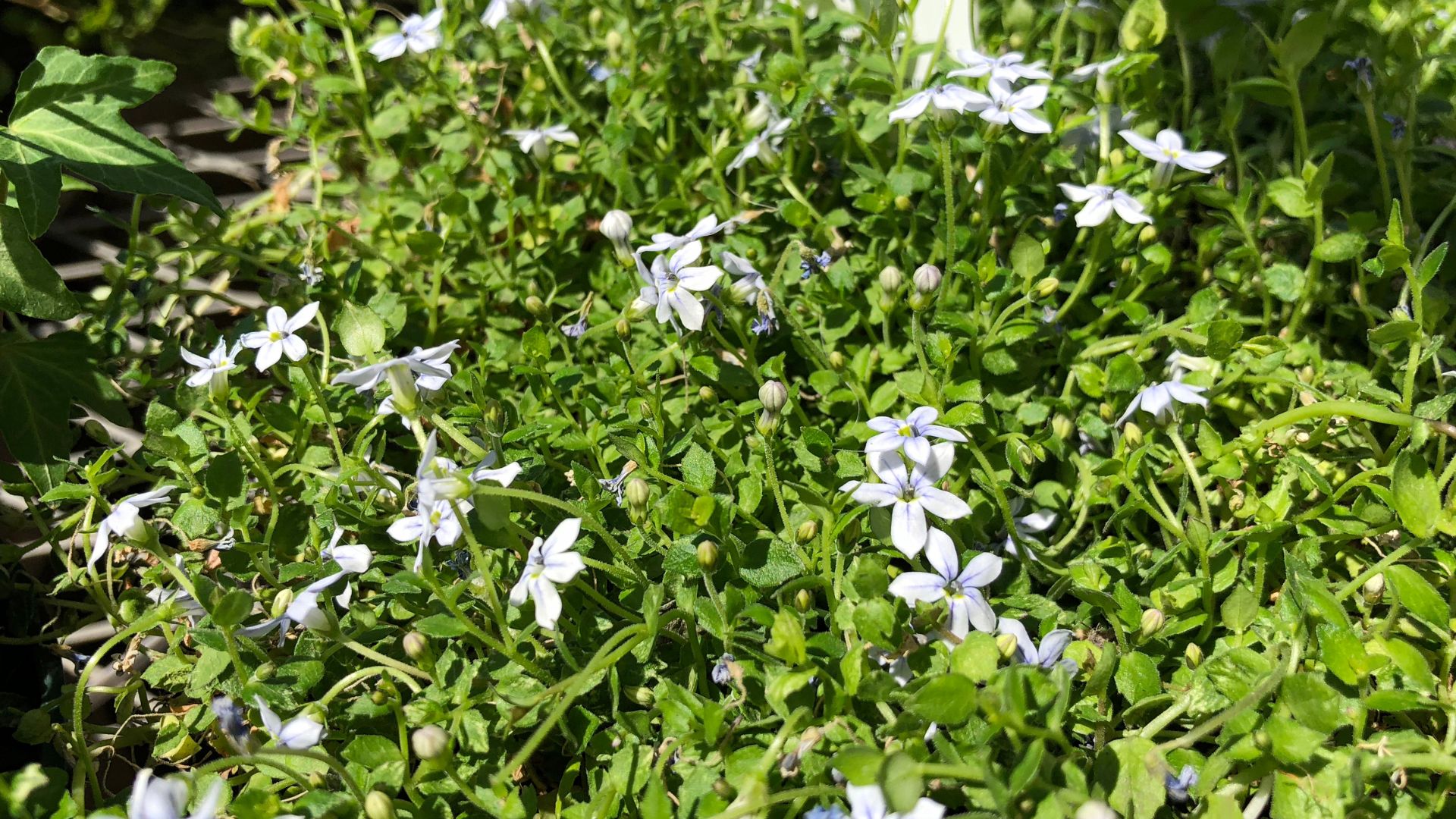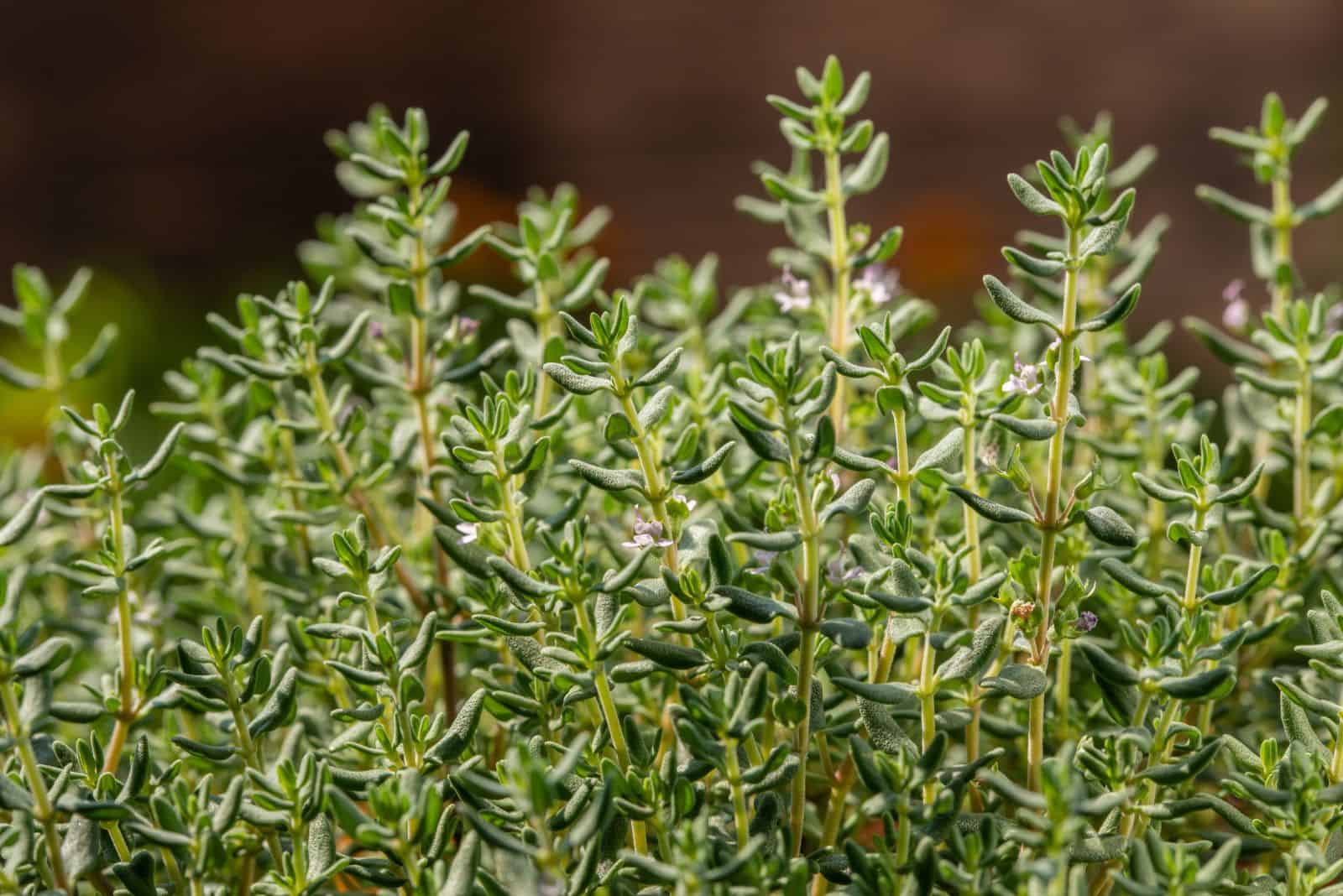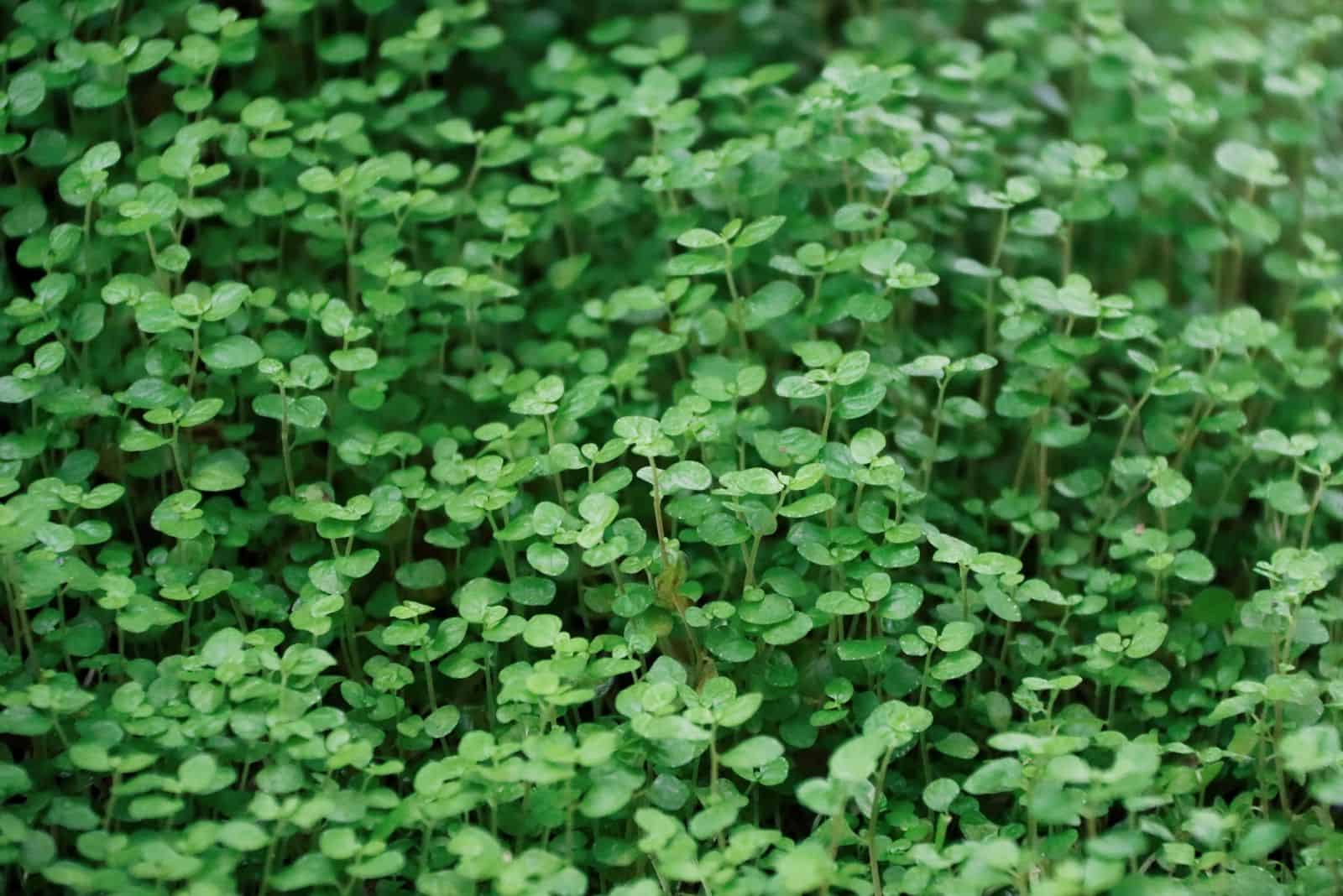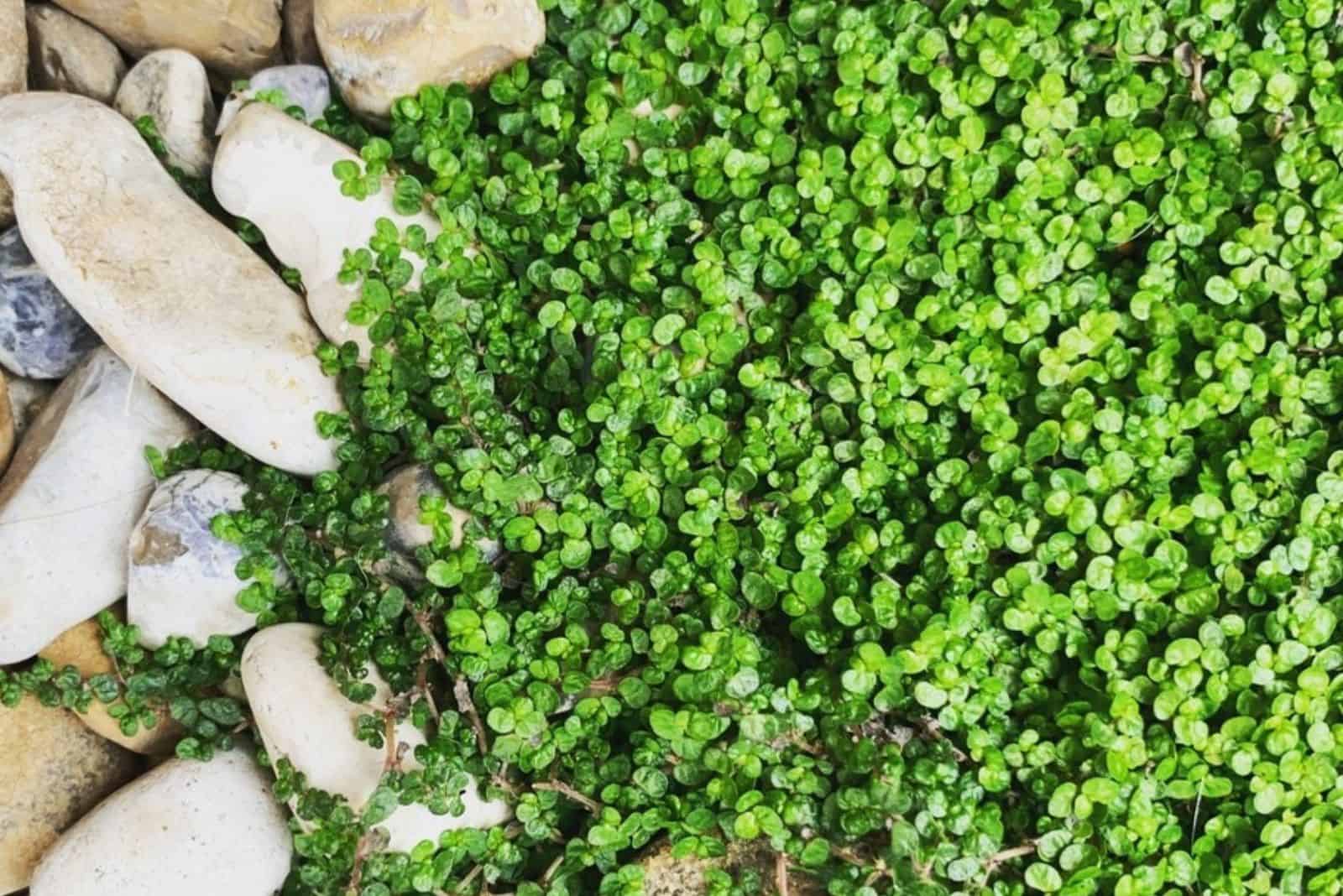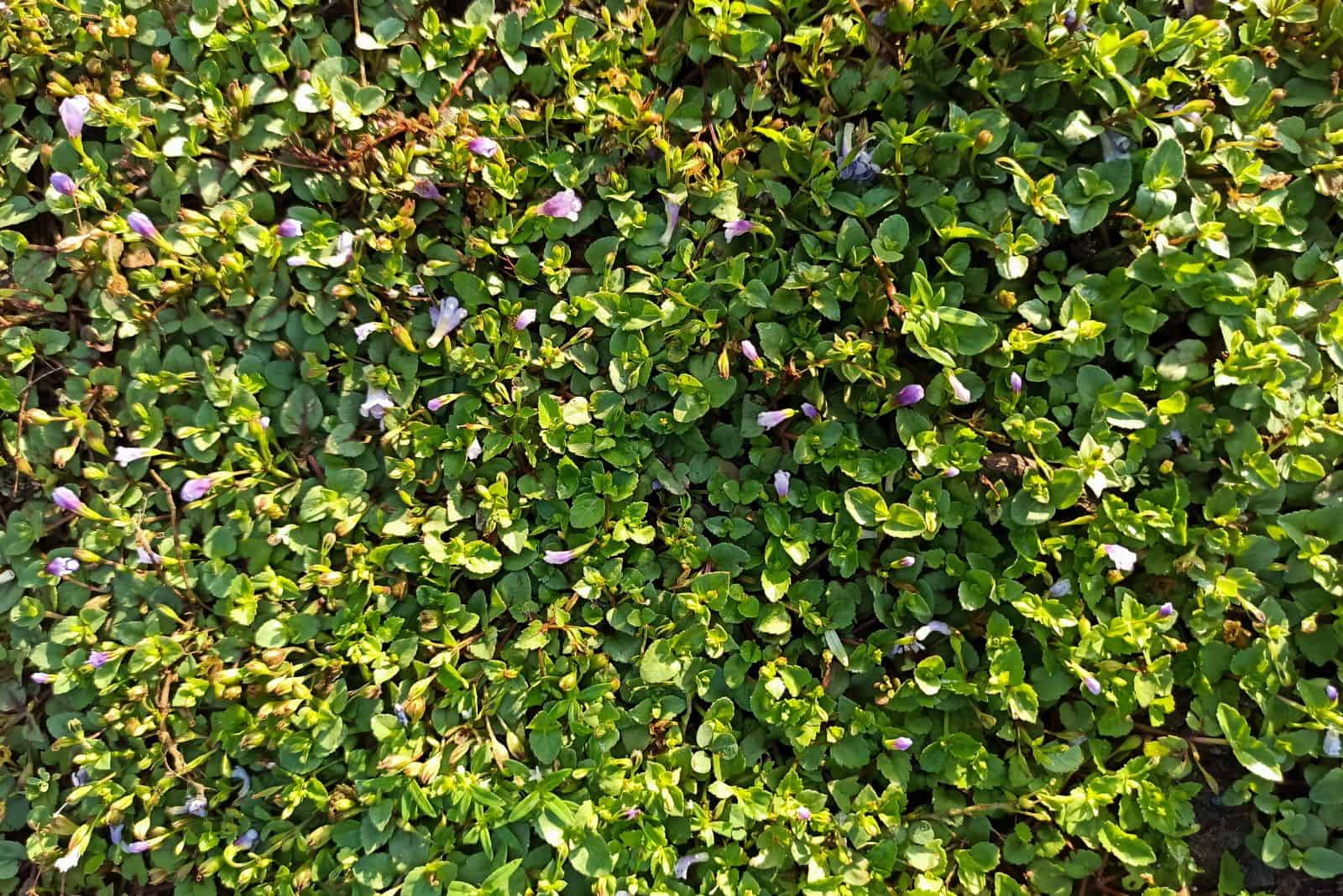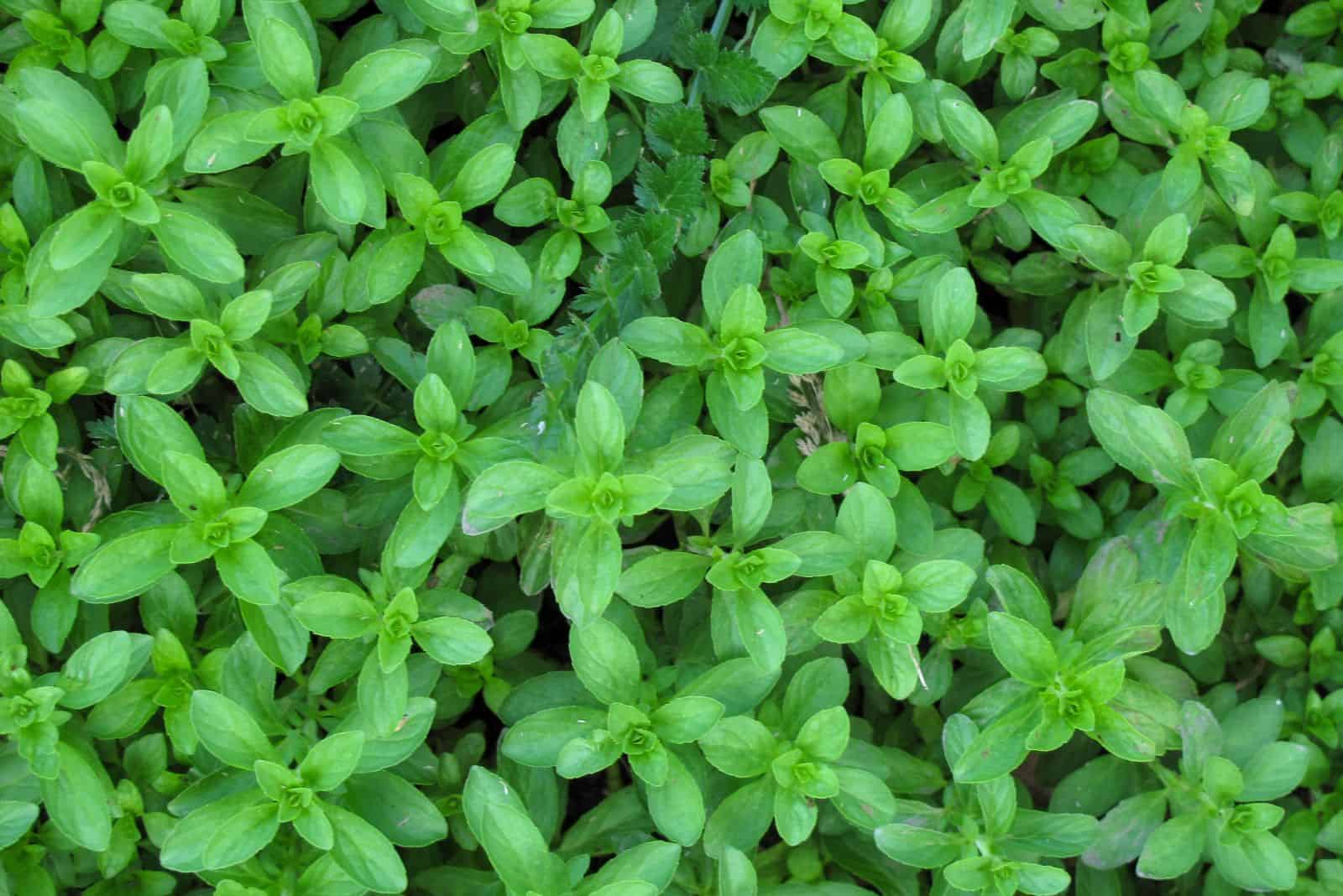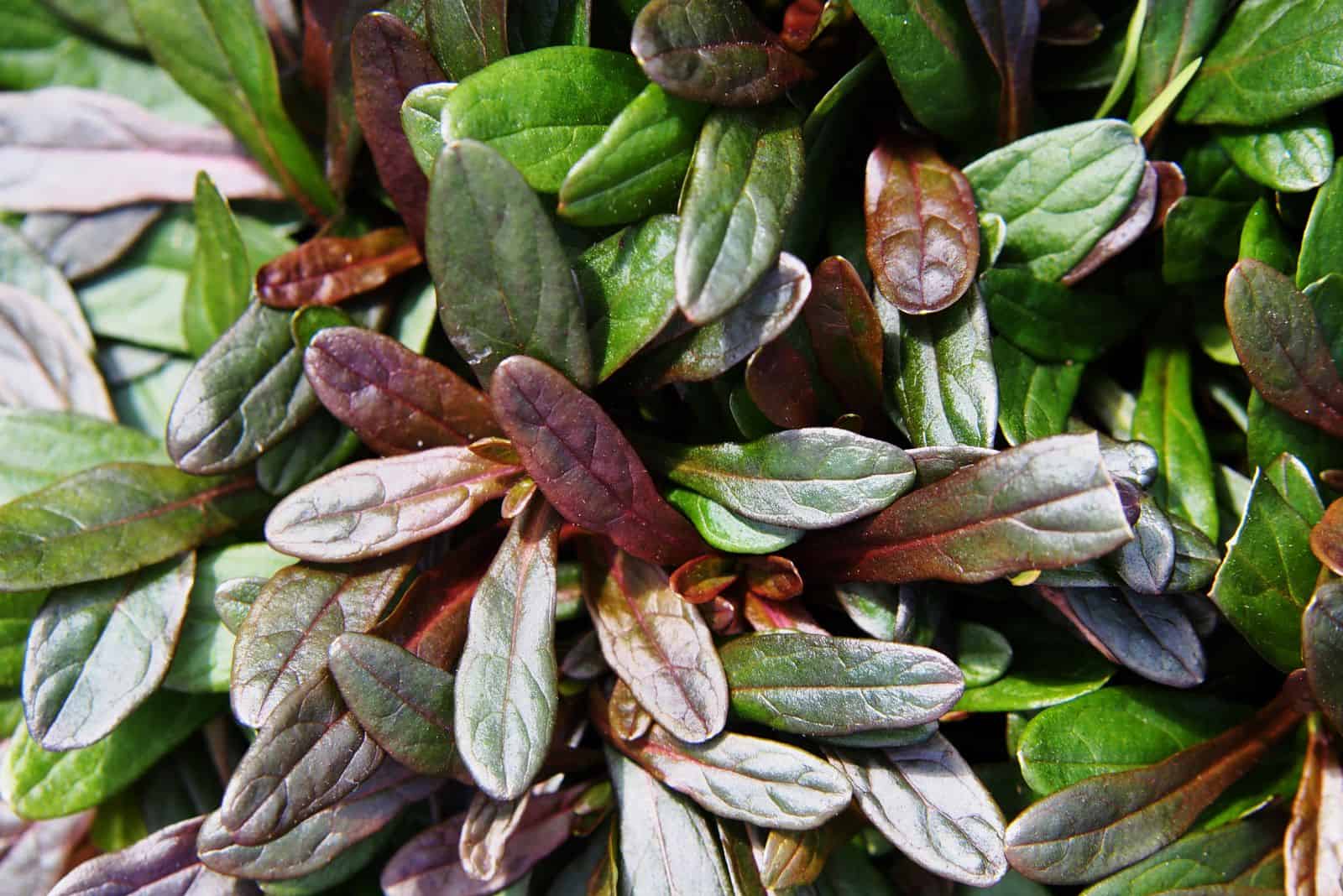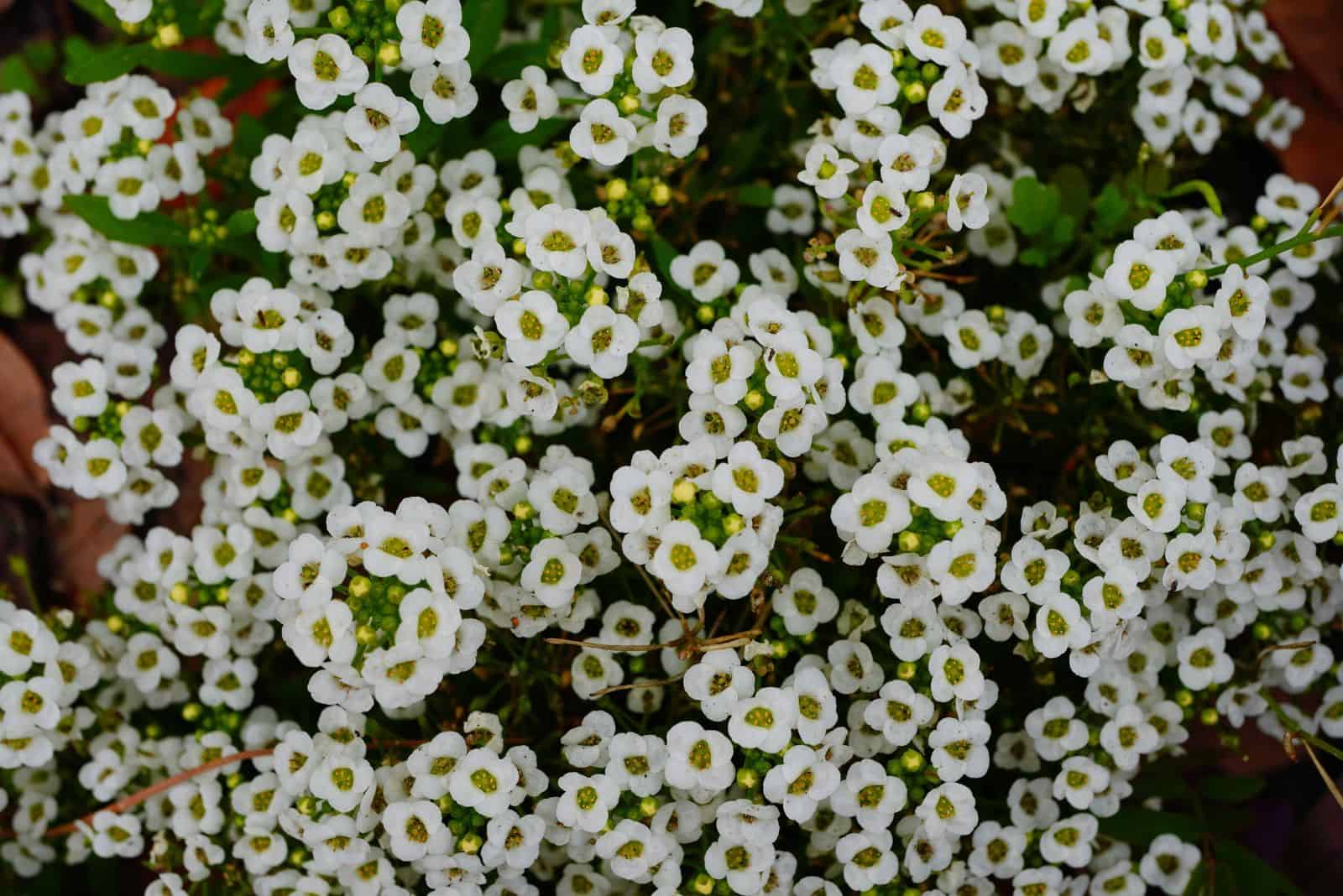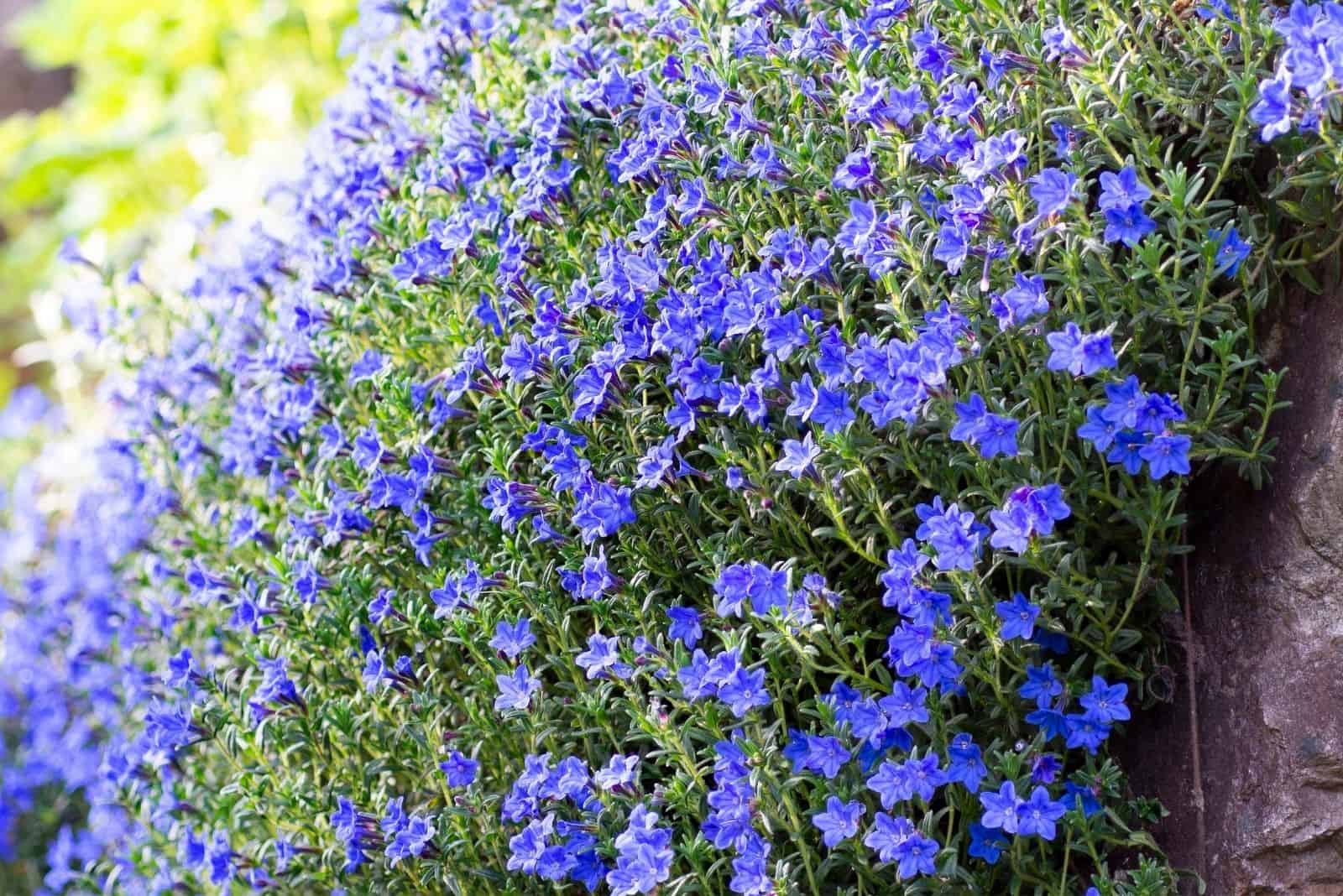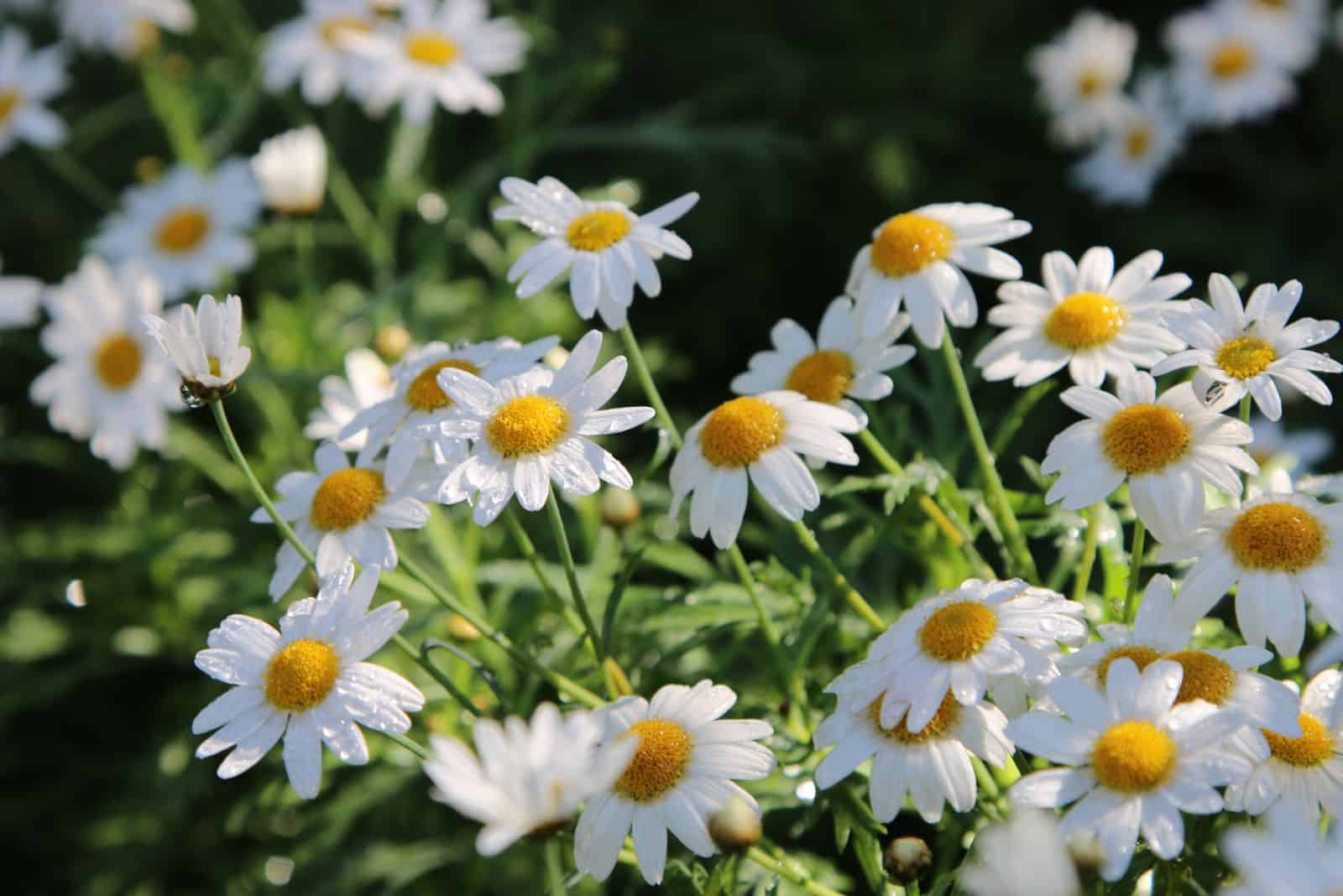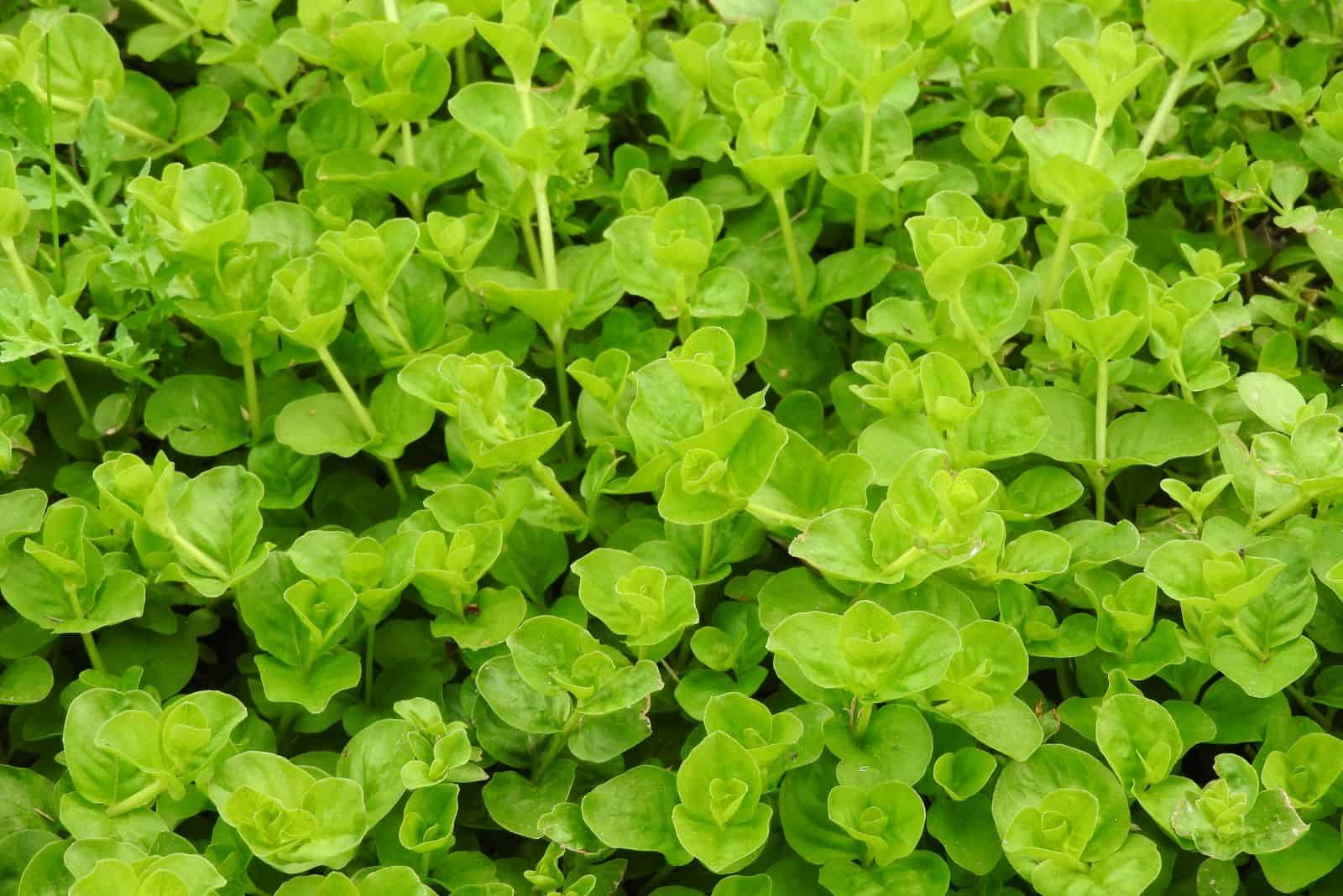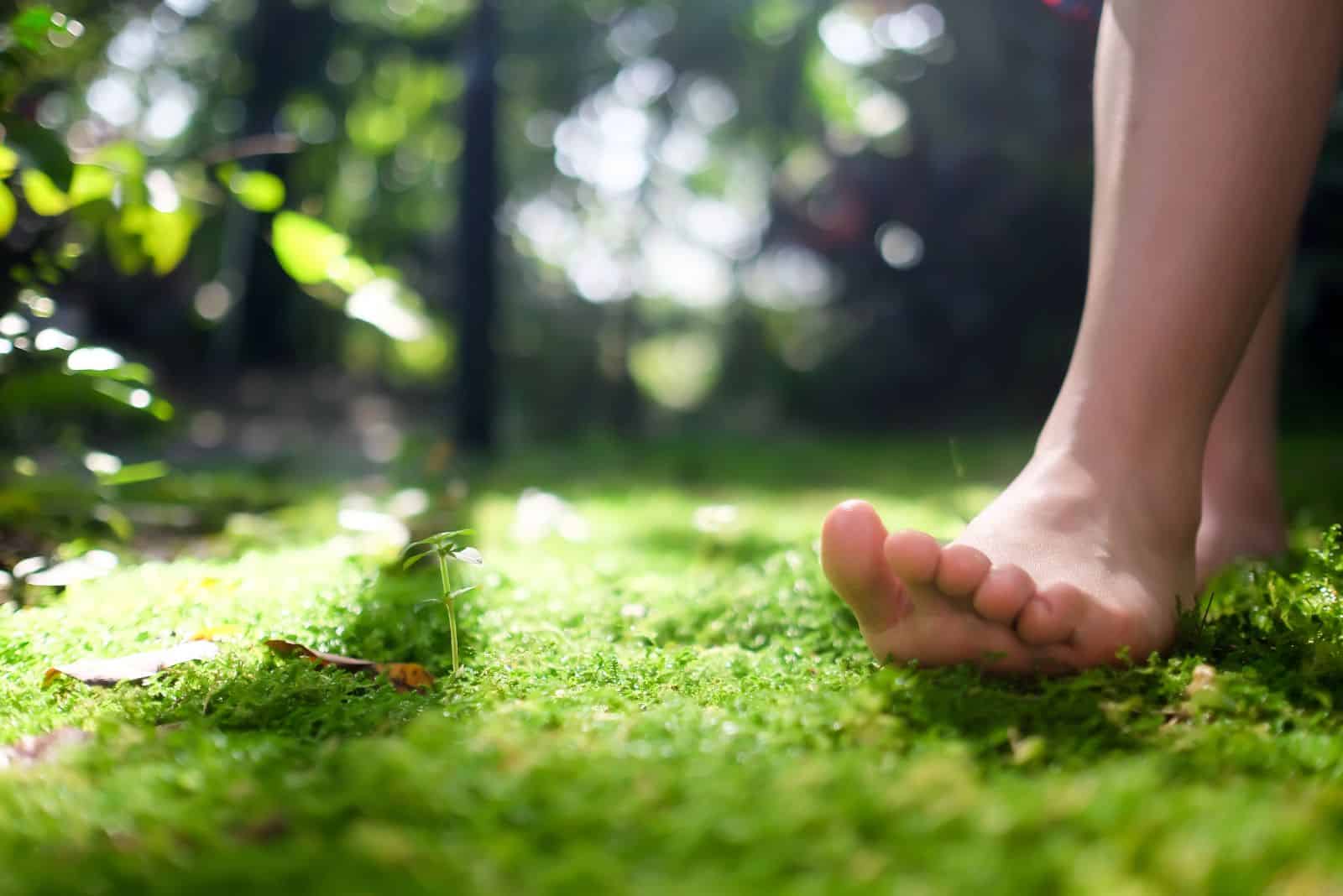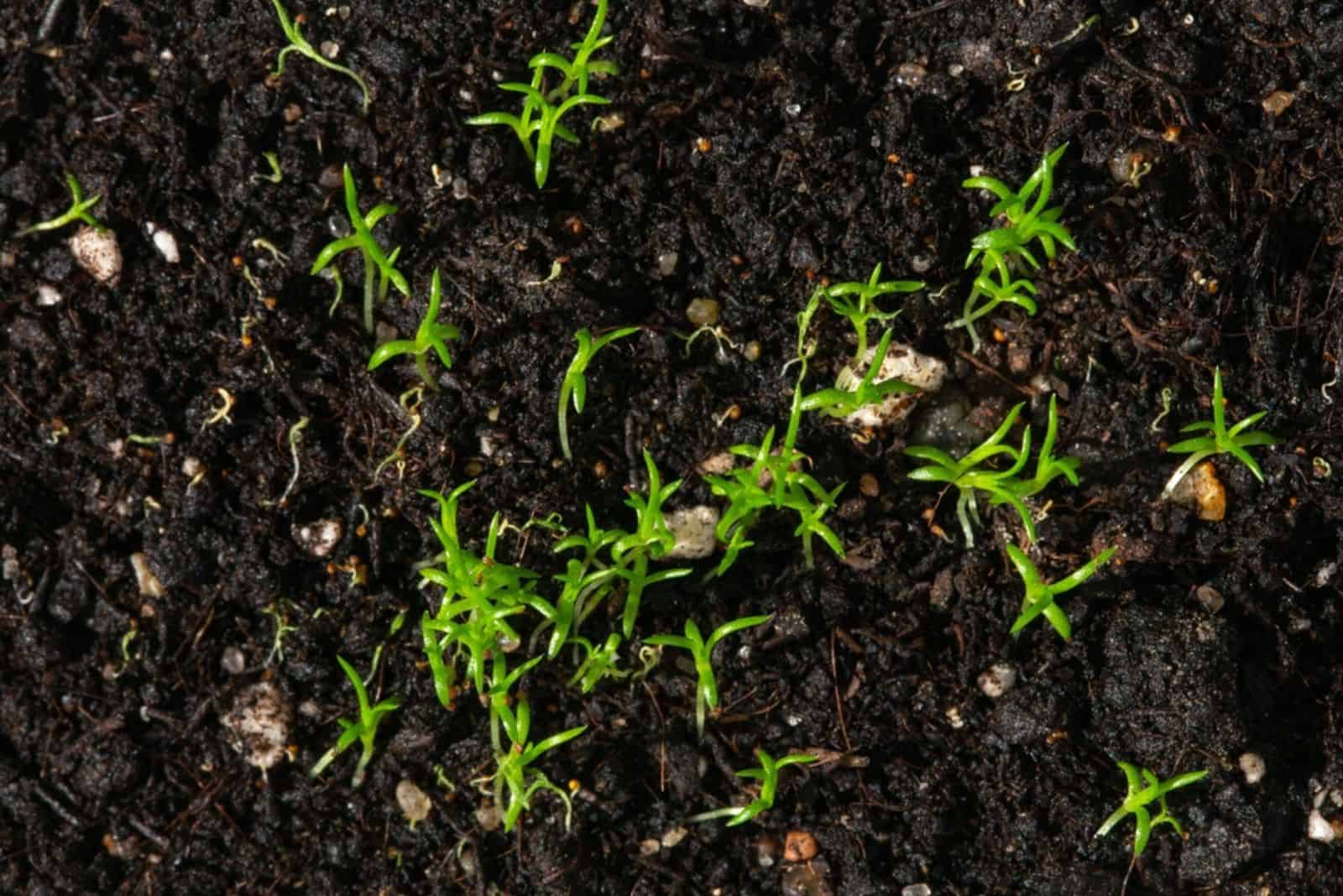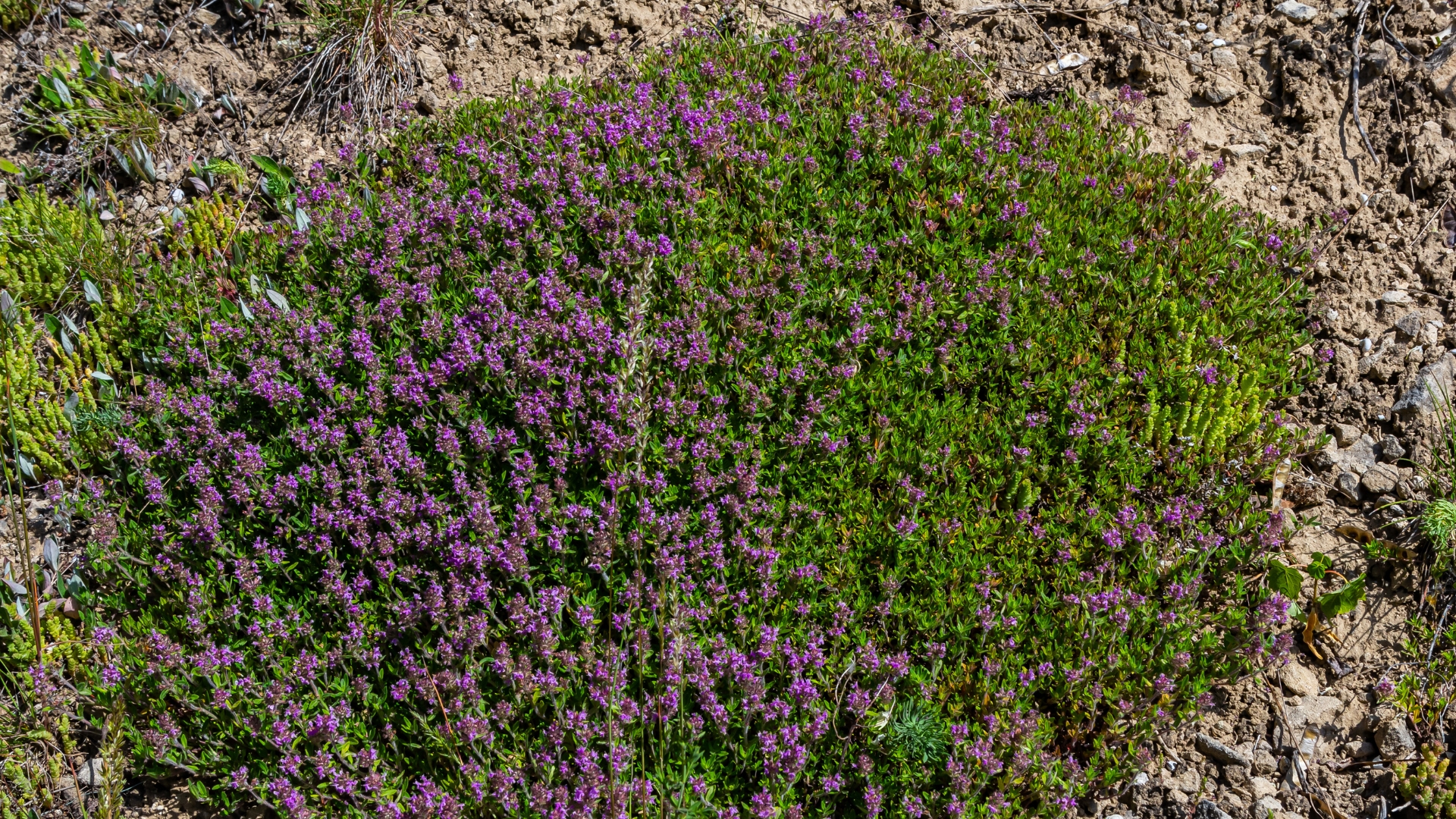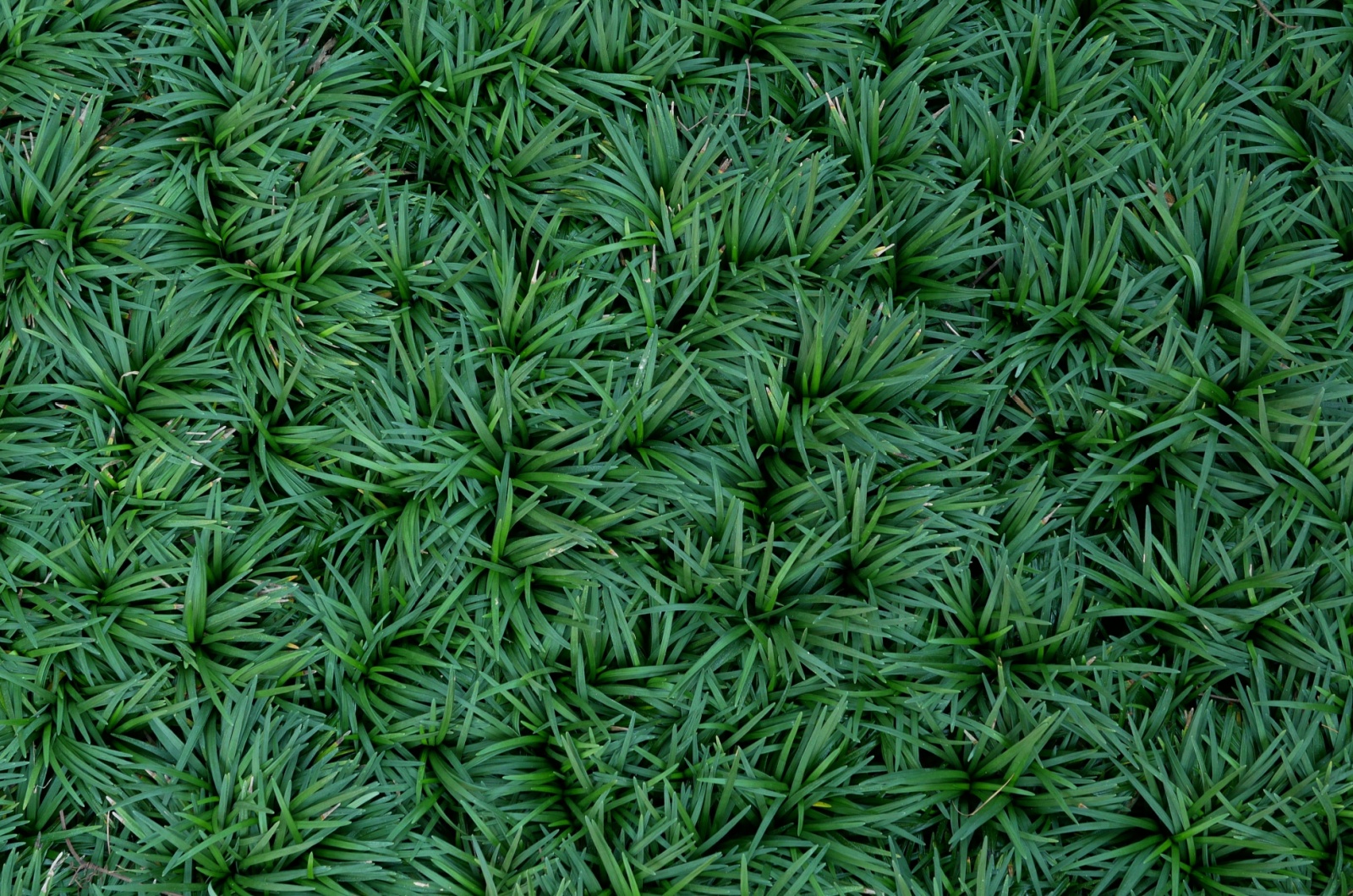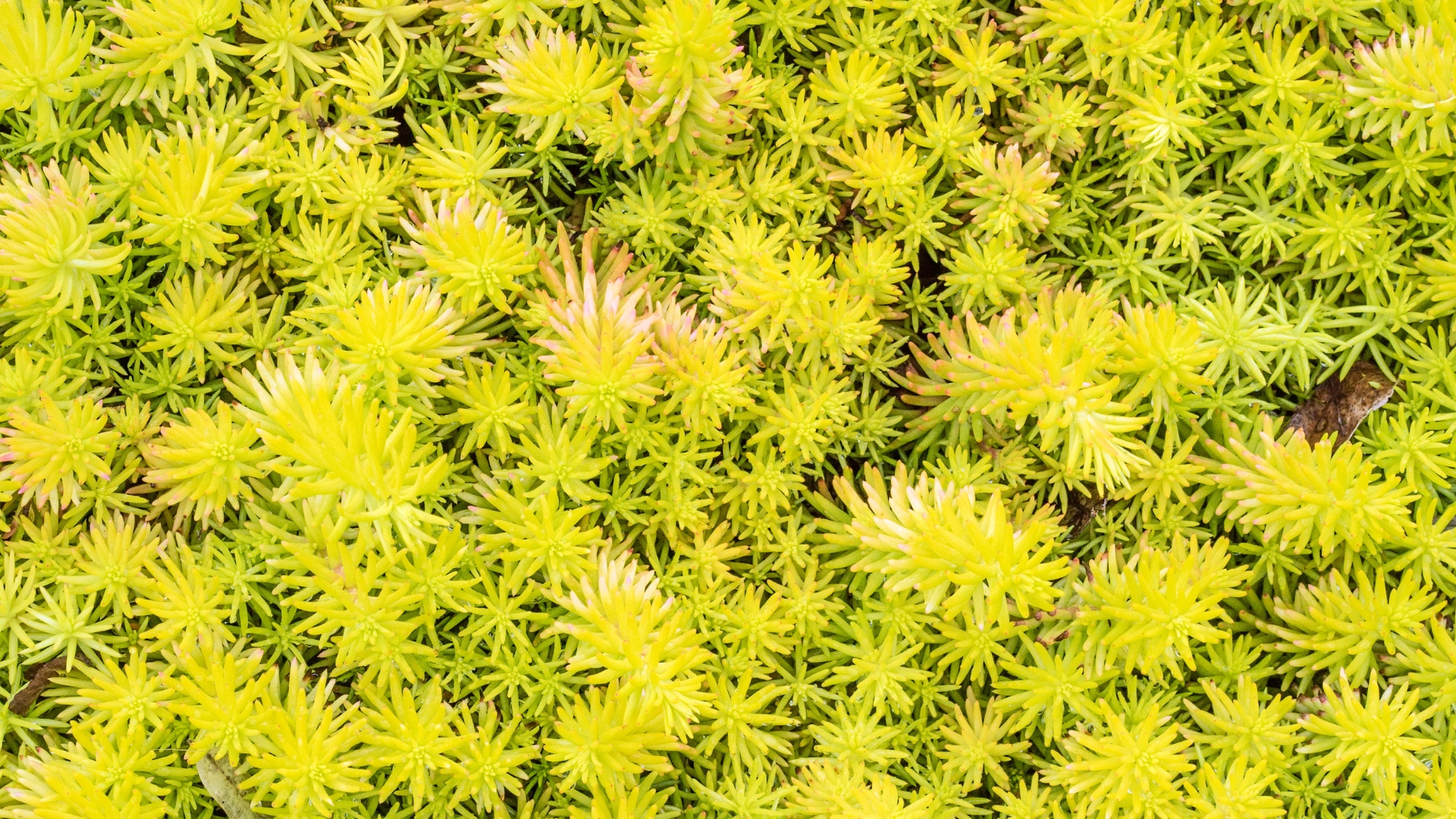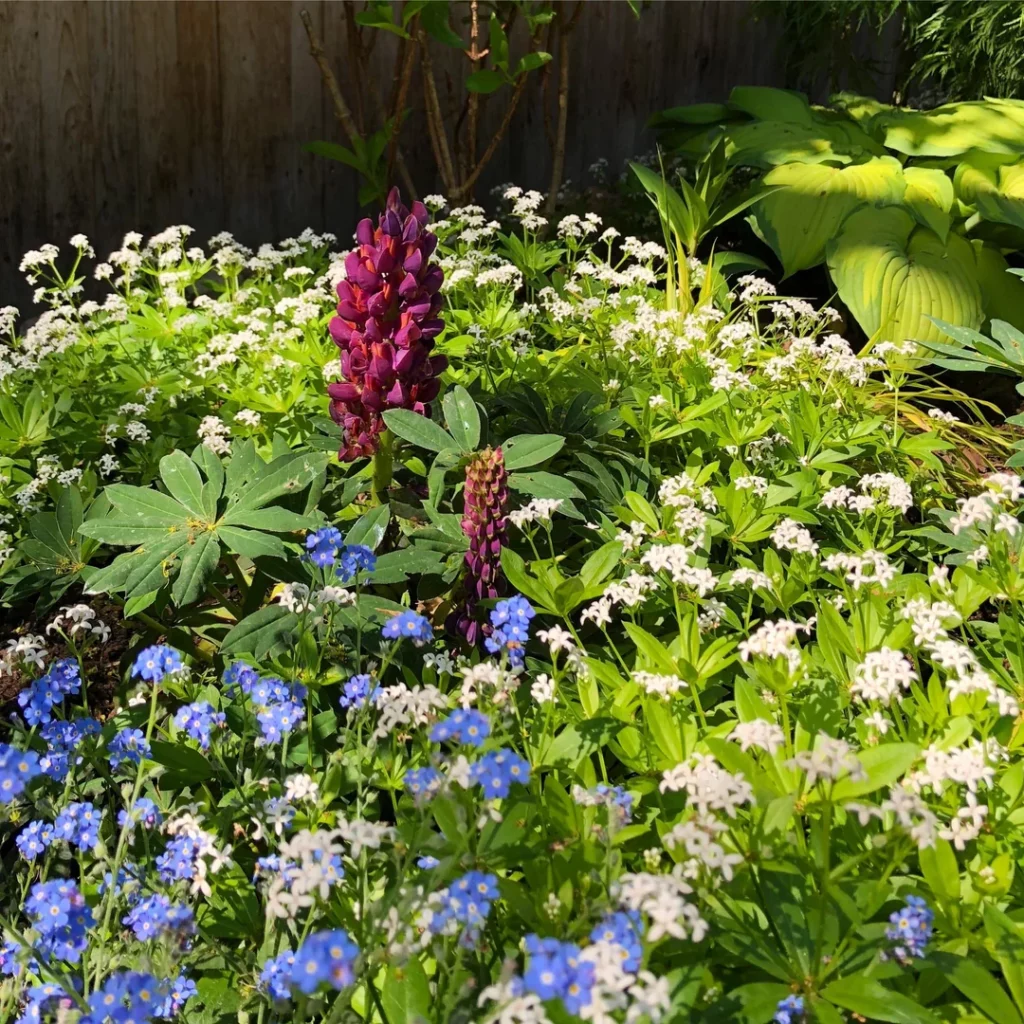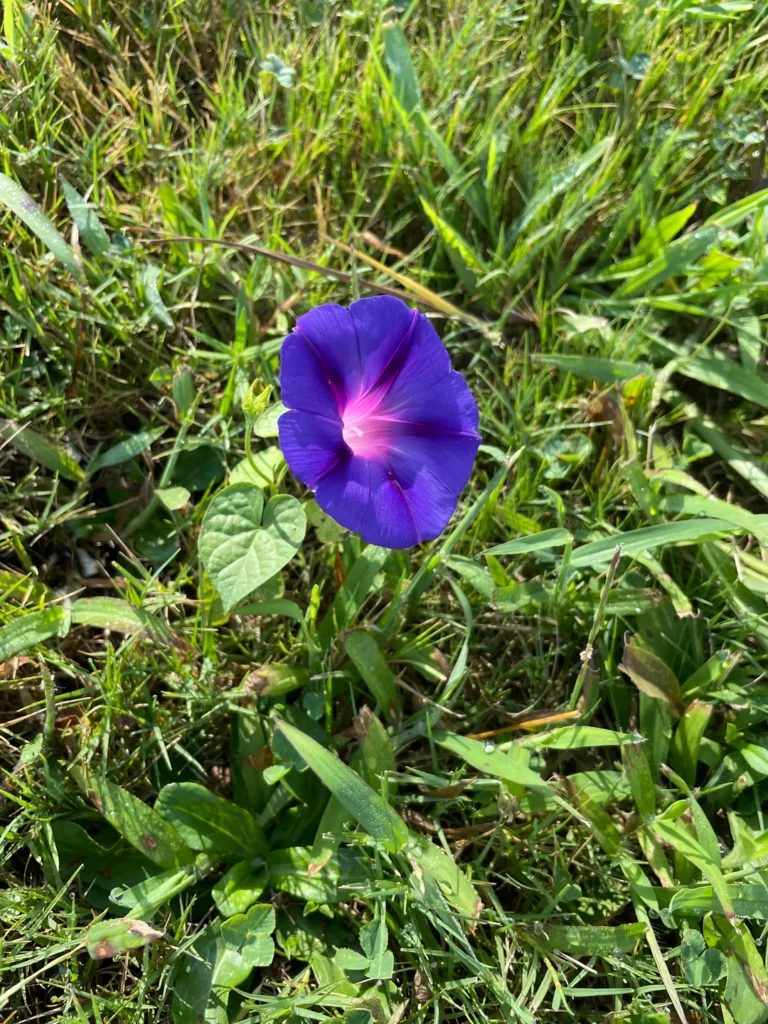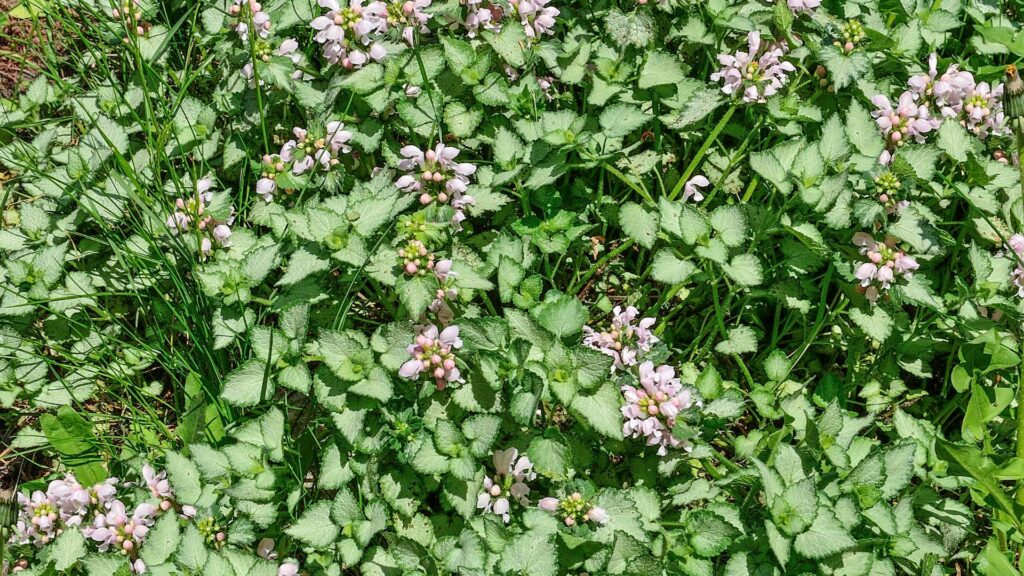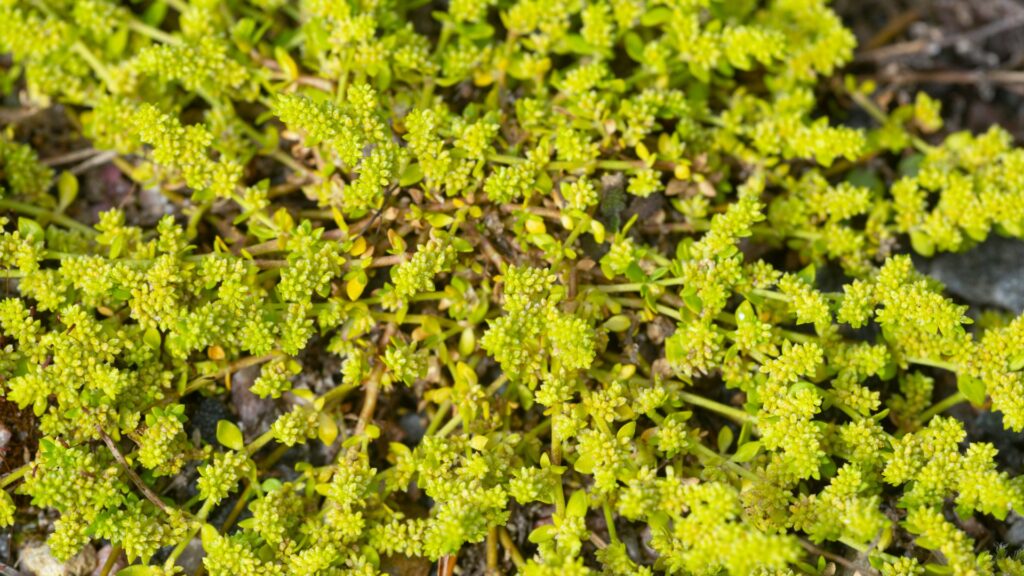Tired of telling everyone to stay off the lawn? It’s time to swap it out for 20 walkable ground cover plants that look gorgeous and handle a little foot traffic.
These low-maintenance beauties will keep your yard lush without the need for constant upkeep. Plus, they add texture and color, making your outdoor space feel fresh and inviting.
Ready to step up your lawn game? Let’s check out these fantastic ground covers!
1. Thyme
Plant size: 4 inches tall, 12 inches spread
Ideal settings: Sunny dry areas, rock gardens, herb gardens, border plant
Garden benefits: Attracting pollinators, suppressing weed growth
Hardiness zones: USDA 2 through 9
Thyme (Thymus spp.) is a versatile herb that produces small, narrow leaves and clusters of tiny flowers in shades of pink, purple, or white, depending on the type of thyme. Most of them have tough leaves, which makes them walkable!
They release a delightful aroma when brushed against or crushed, and their flowers have strong fragrances that can attract pollinators like bees and butterflies.
Creeping thyme is one of the best ground cover plants to suppress weed growth since they grow densely and release chemicals that can prevent seeds from germinating and developing further.
These herbs thrive in full sun, although they can tolerate some shade as well. It can tolerate different soil conditions but thrives in a well-draining, preferably alkaline, soil. Regular watering during the initial stages of growth helps establish strong roots.
Once established, these plants are drought tolerant. They are generally hardy and can tolerate colder climates as well.
2. Corsican Mint
Plant size: 3 inches tall, 12 inches spread
Ideal settings: Edging paths, shaded walkways, between stepping stones
Garden benefits: Ground cover, reduces soil erosion, prevents weed growth
Hardiness zones: USDA 6 through 9
Corsican mint, otherwise known as Mentha requienii, is a low-growing perennial herb that forms a dense mat of small, round leaves and tiny purple flowers. It has a strong scent that resembles peppermint.
This mint thrives in partial shade to full shade conditions, making it perfect for shaded gardens. It prefers growing in moist soil, which is why regular watering is essential, especially during dry periods.
Well-draining soil is also recommended, along with misting to maintain high humidity levels. This herb is not frost-tolerant so you should bring it indoors during the winter months, that is, if you live in a colder climate.
3. Soleirola Solerolii
Plant size: 4 inches tall, 36 inches spread
Ideal settings: Shady areas, humid and damp areas
Garden benefits: Decorative ground cover, prevent weed growth
Hardiness zones: USDA 9 through 11
Soleirola solerolii, commonly known as Baby’s Tears or Mind-Your-Own-Business, is a walkable ground cover plant with tiny, round leaves that grow rather densely, creating a lush and vibrant appearance.
It has a cascading growth habit, which is why it is an excellent choice for rock gardens, hanging baskets, or even as a filler between larger plants.
Baby’s tears thrive in bright, indirect sunlight or partial shade. They can be used as lawn grass alternatives in shaded areas. Be careful though as these baby plants cannot tolerate heavy footfall!
These plants prefer moist soil and are great options for areas where other plants may struggle due to high humidity or poor drainage.
They require regular watering – don’t let the soil dry out completely. Misting is also beneficial, especially if the plant is grown indoors. They are not frost-tolerant so bring them indoors if you live somewhere cold.
4. Mazus Reptans
Plant size: 2 inches tall, 12 inches spread
Ideal settings: Between pavers, along walkways, rock gardens
Garden benefits: Attracting pollinators, natural weed barrier
Hardiness zones: USDA 5 through 8
Here is yet another low-growing perennial that can be walked all over!
Mazus reptans forms a dense ground cover with its small, round leaves. The plant also exhibits lovely flowers in shades of blue, lavender, or white, creating a vibrant carpet-like effect in the garden.
What’s also beneficial is that the plant spreads rather quickly and can fill in bare spaces in no time!
Mazus reptans thrives in full sun to partial shade. It prefers consistently moist soil so frequent watering is required. The plant can benefit from a layer of organic mulch.
This plant is relatively low-maintenance but may require occasional trimming to keep it in bounds and prevent it from spreading too aggressively.
5. Pennyroyal
Plant size: 10 inches tall, 60 inches spread
Ideal settings: Shady, damp areas, between stepping stones, along pathways
Garden benefits: Natural insect repellent, attracting pollinators, reducing soil erosion
Hardiness zones: USDA 6 through 9
Let’s talk about another member of the mint family called Pennyroyal, otherwise known as Mentha pulegium. This is a low-growing herb that produces small, oval leaves with distinctive minty fragrances.
Besides these delicate leaves, the herb also exhibits tiny lavender flowers that add beauty to its overall appearance!
Since it spreads quickly, pennyroyal can be used as a walkable ground cover. This unusual plant thrives in full sun to partial shade. The plant prefers well-draining soil and can tolerate drought conditions, which is why it is perfect for xeriscaping.
This plant can spread vigorously, so regular trimming and containment may be necessary to prevent it from invading other areas of the garden.
6. Ajuga Reptans
Plant size: 6 inches tall, 12 inches spread
Ideal settings: Shaded areas under trees, along borders, or as a ground cover
Garden benefits: Prevents soil erosion and weed growth, attracting pollinators
Hardiness zones: USDA 4 through 9
Ajuga reptans, otherwise known as Bugleweed, is one of the most powerful weed-killing plants out there!
This perennial is known for its attractive foliage and spikes of flowers. The leaves are typically dark green or variegated, and the flowers range from purple to blue, pink, or white.
Bugleweed forms a dense ground cover that can endure traffic from feet and even cars!
Bugleweed grows best in full sun to partial shade. It prefers moist, well-draining soil. However, it can tolerate different soil conditions, including clay or slightly alkaline soils. Occasional watering and pruning will keep the plant happy and healthy!
7. Alyssum
Plant size: 8 inches tall, 18 inches spread
Ideal settings: Rock gardens, along borders, paving edges, or as a ground cover
Garden benefits: Repelling deer, attracting bees and butterflies, suppressing weed growth
Hardiness zones: USDA 3 through 7
Alyssum is a lovely colorful flower for your garden that produces clusters of tiny, fragrant flowers with white, pink, lavender, or yellow colors. Alyssum has small, lance-shaped leaves and a low, spreading growth habit.
These leaves and flowers can spread quickly and create a charming colorful carpet!
Besides its endurance to high foot traffic, alyssum is also known for tolerating extended periods of drought. However, adequate watering helps promote healthy growth and abundant flowering.
It thrives in full sun, but can grow in partial shade as well. The plant can tolerate various soil types, including sandy or rocky soils.
8. Lithodora Diffusa
Plant size: 6 inches tall, 18 inches spread
Ideal settings: Rock gardens, borders, or as a ground cover in dry areas
Garden benefits: Evergreen foliage provides year-round interest, attracting pollinators
Hardiness zones: USDA 6 through 9
Here is another walkable ground cover plant that originates from the Mediterranean region. Lithodora diffusa is a vibrant perennial with small, glossy leaves and deep blue, star-shaped flowers.
This plant can make your garden look like it came straight out of a fairy tale!
Lithodora has a trailing growth habit, making it ideal for cascading over walls or in rock gardens. It is also great for pathways and gravel gardens.
Full sun or partial shade are ideal conditions for Lithodora diffusa. It thrives in well-draining soil, such as loamy or sandy. The plant should be watered during dry periods. Adding mulch can help with moisture retention.
9. Chamomile Nobile
Plant size: 6 inches tall, 12 inches spread
Ideal settings: Rock gardens, between pavers, borders
Garden benefits: Creating a soothing atmosphere, attracting pollinators
Hardiness zones: USDA 4 through 9
Chamomile nobile is a lovely perennial herb that produces feathery leaves and daisy-like flowers. It has a spreading growth habit and forms a lush carpet of foliage, which is why it can be used in smaller backyards or low-traffic areas, or as an aromatic place to lie down.
This herb can grow in both full sun and partial shade. It prefers slightly alkaline soil but can adapt to different types of soil. Chamomile should be watered during long dry periods. Trimming back after flowering can encourage new growth.
You can grow it together with mint as it is a great chamomile companion plant!
10. Creeping Jenny
Plant size: 6 inches tall, 18 inches spread
Ideal settings: Shady slopes, filling bare spots, or growing as a trailing plant in containers
Garden benefits: Preventing weed growth, attracting beneficial insects
Hardiness zones: USDA 3 through 9
With its trailing stems and rounded, bright yellow-green leaves, this hardy perennial plant creates a wonderful walkable ground cover. Weed establishment and growth are reduced thanks to its robust growth.
Creeping Jenny also produces vibrant yellow flowers during the summer, adding a pop of color to its lush foliage.
This plant is relatively low-maintenance and can tolerate light foot traffic. Regular pruning or trimming can help control its spread and maintain a tidy appearance.
Creeping Jenny thrives in both direct sunlight and light shade. It can endure brief dry periods but prefers regularly damp environments. Consistent watering is required to keep the plant healthy, especially during hot and dry months.
11. Moss
Plant size: 4 inches tall, 36 inches spread
Ideal settings: Rock gardens, woodland gardens, or as a ground cover under trees
Garden benefits: Purify air, retain moisture, support biodiversity
Hardiness zones: USDA 4 through 9
We are ending our list with a unique and versatile moss. This plant forms a dense mat of tiny, delicate green foliage that can be grown as lawn alternatives.
Even though we are often trying to get rid of moss, why not just let it grow and have a moss lawn instead?
Moss Acres stated: “Sheet moss is durable – it can be walked upon, and once established in a shady area, does not require watering to survive – it only helps keep it looking lush during periods of drought. Mosses are actually much more resilient than grass during droughts.”
Moss thrives in shaded or partially shaded areas with high humidity and moisture. It prefers acidic soil and can tolerate poor soil conditions. It benefits from regular misting and watering.
Lawn moss is relatively low-maintenance and doesn’t require mowing or trimming like traditional lawns.
12. Irish Moss
Plant size: 2 inches tall, 12 inches spread
Ideal settings: Between stepping stones, rock gardens, shaded pathways
Garden benefits: Moisture retention, weed suppression, lush green carpet
Hardiness zones: USDA 4 through 9
Irish moss (Sagina subulata) creates a soft, cushiony carpet of tiny, bright green foliage that adds a lush and inviting touch to any space. It spreads beautifully between stepping stones or across shaded pathways, forming a dense, low-maintenance ground cover.
This plant thrives in moist, well-draining soil and partial shade but can handle full sun in cooler climates. Regular watering will keep it looking fresh, especially in dry conditions. While it can tolerate light foot traffic, it’s best suited for areas with occasional walking rather than high-traffic zones.
13. Blue Star Creeper
Plant size: 3 inches tall, 18 inches spread
Ideal settings: Between pavers, pathways, and borders
Garden benefits: Attracts pollinators, spreads quickly, requires little maintenance
Hardiness zones: USDA 6 through 9
Blue star creeper (Isotoma fluviatilis) is a hardy ground cover with small, delicate leaves and charming light blue star-shaped flowers. It forms a dense, soft mat that’s perfect for filling in spaces between stepping stones, along pathways, or around garden borders.
This plant loves full sun to partial shade and thrives in well-draining soil. Once established, it requires minimal care and can handle moderate foot traffic, making it a great alternative to traditional grass.
14. Elfin Creeping Thyme
Plant size: 2 inches tall, 12 inches spread
Ideal settings: Between flagstones, rock gardens, pathways
Garden benefits: Fragrant foliage, attracts pollinators, weed suppression
Hardiness zones: USDA 4 through 9
Elfin creeping thyme (Thymus serpyllum ‘Elfin’) is a compact, low-growing herb that forms a dense, aromatic ground cover. Its tiny purple flowers bloom in summer, attracting bees and butterflies while releasing a pleasant scent when walked on.
This variety of thyme thrives in full sun and well-draining soil, making it perfect for sunny pathways, garden borders, or stepping stone areas. It requires little maintenance and is drought-tolerant once established, making it a fantastic choice for low-water landscapes.
15. Dwarf Mondo Grass
Plant size: 4 inches tall, 12 inches spread
Ideal settings: Pathway edging, between pavers, shaded gardens
Garden benefits: Evergreen foliage, erosion control, drought tolerance
Hardiness zones: USDA 6 through 10
Dwarf mondo grass (Ophiopogon japonicus ‘Nana’) is a hardy, low-growing grass-like plant that forms a thick, evergreen carpet. It’s an excellent alternative to traditional turf, especially in shaded gardens where other ground covers struggle.
It thrives in partial to full shade and adapts to various soil types, as long as they are well-draining. Once established, it’s drought-tolerant and requires minimal upkeep, making it an easy and elegant ground cover choice.
16. Sedum ‘Angelina’
Plant size: 4 inches tall, 24 inches spread
Ideal settings: Rock gardens, slopes, sunny pathways
Garden benefits: Drought-tolerant, prevents soil erosion, provides winter interest
Hardiness zones: USDA 3 through 9
Sedum ‘Angelina’ (Sedum rupestre ‘Angelina’) is a vibrant, golden-yellow ground cover with a soft, trailing growth habit. It spreads quickly, filling in gaps between stepping stones or covering dry, sunny areas where other plants struggle.
This sedum thrives in full sun and well-drained soil, requiring very little water once established. It can handle moderate foot traffic, making it a durable and eye-catching addition to walkable landscapes. Plus, its foliage takes on a striking orange hue in colder months, adding year-round beauty.
17. Sweet Woodruff
Plant size: 6 inches tall, 18 inches spread
Ideal settings: Shaded gardens, woodland areas
Garden benefits: Aromatic foliage, weed control, attracts pollinators
Hardiness zones: USDA 4 through 8
Sweet Woodruff (Galium odoratum) is a charming, low-growing perennial that thrives in shady, woodland environments. Known for its fragrant, star-shaped white flowers in the spring and its bright green foliage, this ground cover adds both texture and fragrance to shaded areas.
It’s perfect for planting under trees, along shaded garden borders, or in moist, woodland-like settings. The dense growth habit of Sweet Woodruff helps suppress weeds, while the aromatic leaves are crushed to release a sweet, hay-like scent.
18. Ground Morning Glory
Plant size: 6 to 12 inches tall, spreading 12 to 24 inches
Ideal settings: Sunny areas, slopes, coastal gardens
Garden benefits: Fast-growing, vibrant flowers, erosion control
Hardiness zones: USDA 5 through 9
Ground Morning Glory (Convolvulus sabatius) is an eye-catching perennial ground cover that thrives in full sun and well-drained soil. With its bright, funnel-shaped flowers in shades of purple, blue, or white, it provides a vibrant splash of color to your landscape throughout the summer months.
This fast-growing plant is perfect for sunny borders, slopes, or hanging baskets, as it spreads rapidly, forming a dense mat. Ground Morning Glory is great for erosion control on slopes and embankments.
19. Silver Carpet
Plant size: 2 inches tall, 18 inches spread
Ideal settings: Between stepping stones, sunny pathways, coastal gardens
Garden benefits: Drought-tolerant, suppresses weeds, handles moderate foot traffic
Hardiness zones: USDA 9 through 11
Silver Carpet, also known as Dymondia margaretae, is a hardy, drought-tolerant ground cover that forms a dense mat of narrow, gray-green leaves with silvery undersides. It produces small, daisy-like yellow flowers in summer, adding subtle charm to its silvery foliage.
This South African native thrives in full sun and well-draining soil, making it ideal for xeriscaping and dry climates. It can tolerate light to moderate foot traffic, making it a popular choice between stepping stones or along sunny walkways.
Once established, Silver Carpet is low-maintenance and needs only occasional watering. Its thick growth helps suppress weeds and retains soil moisture, making it a smart, stylish lawn alternative.
20. Rupturewort
Plant size: 1 to 2 inches tall, 12 to 18 inches spread
Ideal settings: Between pavers, dry slopes, sunny paths
Garden benefits: Extremely tolerant to foot traffic, erosion control, drought-resistant
Hardiness zones: USDA 5 through 9
Herniaria glabra, or Rupturewort, is one of the toughest low-growing ground covers available. It forms a tight, green carpet with fine-textured foliage and inconspicuous greenish flowers. Though not flashy, its durability is unmatched.
It tolerates heavy foot traffic and drought, making it a reliable lawn substitute for dry, sunny areas or high-traffic paths. Rupturewort thrives in full sun and well-drained soils, and once established, it needs very little water.
This plant stays green even in dry conditions and requires no mowing or trimming—ideal for hands-off landscaping with plenty of practical appeal.

